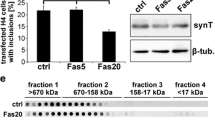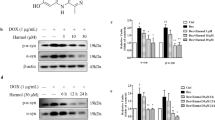Abstract
Potentially druggable mechanisms underlying synaptic deficits seen in Parkinson's disease (PD) and dementia with Lewy bodies (DLB) are under intense interrogations. In addition to defective synaptic vesicle trafficking, cytoskeletal disruption, autophagic perturbation, and neuroinflammation, hyperphosphorylation of microtubule-associated protein collapsin response mediator protein 2 (CRMP2, also known as DPYSL2) is newly determined to correlate with synaptic deficits in human DLB. The small molecule experimental therapeutic, lanthionine ketimine-5-ethyl ester (LKE), appears to interact with CRMP2 in a host of neurodegenerative mouse models, normalizing its phosphorylation level while promoting healthful autophagy in cell culture models and suppressing the proinflammatory phenotype of activated microglia. Accordingly, this study examined the effect of LKE on α-synuclein A53T transgenic (Tg) mice which were employed as a DLB model. We found that chronic administration of LKE to A53T mice suppressed (1) the accumulation of LBs, (2) neuroinflammatory activation of microglia, (3) impairment of contextual fear memory, and (4) CRMP2 phosphorylation at Thr509 in A53T Tg mice. These results suggest that CRMP2 phosphorylation by GSK3β in the hippocampus is related to pathology and memory impairment in DLB, and LKE may have clinical implications in the treatment of α-synucleinopathy.





Similar content being viewed by others
Data Availability
The data that support the findings of this study are available from the corresponding author upon request.
References
Hely MA, Reid WGJ, Adena MA, Halliday GM, Morris JGL (2008) The Sydney multicenter study of Parkinson’s disease: the inevitability of dementia at 20 years. Mov Disord 23:837–844. https://doi.org/10.1002/MDS.21956
Li J, Uversky VN, Fink AL (2001) Effect of familial Parkinson’s disease point mutations A30P and A53T on the structural properties, aggregation, and fibrillation of human alpha-synuclein. Biochemistry 40:11604–11613. https://doi.org/10.1021/BI010616G
Dhavale DD, Tsai C, Bagchi DP, Engel LA, Sarezky J, Kotzbauer PT (2017) A sensitive assay reveals structural requirements for α-synuclein fibril growth. J Biol Chem 2292:9034. https://doi.org/10.1074/JBC.M116.767053
α-synuclein A53T Mouse (Tg) | ALZFORUM. Accessed January 15, 2022. https://www.alzforum.org/research-models/synuclein-a53t-mouse-tg
Lee MK, Stirling W, Xu Y et al (2002) Human-synuclein-harboring familial Parkinson’s disease-linked Ala-53 3 Thr mutation causes neurodegenerative disease with-synuclein aggregation in transgenic mice. Proc Natl Acad Sci USA 99:8968–8973. https://doi.org/10.1073/pnas.132197599
Masuda-Suzukake M, Nonaka T, Hosokawa M et al (2013) Prion-like spreading of pathological α-synuclein in brain. Brain 136:1128–1138. https://doi.org/10.1093/BRAIN/AWT037
Jang A, Lee HJ, Suk JE, Jung JW, Kim KP, Lee SJ (2010) Non-classical exocytosis of alpha-synuclein is sensitive to folding states and promoted under stress conditions. J Neurochem 113:1263–1274. https://doi.org/10.1111/J.1471-4159.2010.06695.X
Lee H-J, Kim C, Lee S-J (2010) Alpha-synuclein stimulation of astrocytes: potential role for neuroinflammation and neuroprotection. Oxid Med Cell Longev 3:283–287. https://doi.org/10.4161/oxim.3.4.12809
Daniele SG, Béraud D, Davenport C, Cheng K, Yin H, Maguire-Zeiss KA (2015) Activation of MyD88-dependent TLR1/2 signaling by misfolded α-synuclein, a protein linked to neurodegenerative disorders. Sci Signal. https://doi.org/10.1126/SCISIGNAL.2005965
Crews L, Spencer B, Desplats P et al (2010) Selective molecular alterations in the autophagy pathway in patients with Lewy body disease and in models of α-synucleinopathy. PLoS ONE 5:e9313. https://doi.org/10.1371/journal.pone.0009313
Gallagher LE, Chan EYW (2013) Early signalling events of autophagy. Essays Biochem 55:1–15. https://doi.org/10.1042/BSE0550001/78230
Minakaki G, Menges S, Kittel A et al (2018) Autophagy inhibition promotes SNCA/alpha-synuclein release and transfer via extracellular vesicles with a hybrid autophagosome-exosome-like phenotype. Autophagy 14:98. https://doi.org/10.1080/15548627.2017.1395992
Nakamura F, Ohshima T, Goshima Y (2020) Collapsin response mediator proteins: their biological functions and pathophysiology in neuronal development and regeneration. Front Cell Neurosci 14:188. https://doi.org/10.3389/fncel.2020.00188
Wang L-H, Strittmatter SMA (1996) Family of rat CRMP genes is differentially expressed in the nervous system. J Neurosci 16:6197–6207
Uchida Y, Ohshima T, Sasaki Y et al (2005) Semaphorin3A signalling is mediated via sequential Cdk5 and GSK3β phosphorylation of CRMP2: implication of common phosphorylating mechanism underlying axon guidance and Alzheimer’s disease. Genes Cells 10:165–179. https://doi.org/10.1111/J.1365-2443.2005.00827.X
Yoshimura T, Kawano Y, Arimura N, Kawabata S, Kikuchi A, Kaibuchi K (2005) GSK-3β regulates phosphorylation of CRMP-2 and neuronal polarity. Cell 120:137–149. https://doi.org/10.1016/j.cell.2004.11.012
Harris-White ME, Ferbas KG, Johnson MF et al (2015) A cell-penetrating ester of the neural metabolite lanthionine ketimine stimulates autophagy through the mTORC1 pathway: evidence for a mechanism of action with pharmacological implications for neurodegenerative pathologies. Neurobiol Dis 84:60–68. https://doi.org/10.1016/j.nbd.2015.03.007
Xing H, Lim YA, Chong JR et al (2016) Increased phosphorylation of collapsin response mediator protein-2 at Thr514 correlates with β-amyloid burden and synaptic deficits in Lewy body dementias. Mol Brain 9:84. https://doi.org/10.1186/s13041-016-0264-9
Hensley K, Venkova K, Christov A (2010) Emerging biological importance of central nervous system lanthionines. Molecules 15:5581–5594. https://doi.org/10.3390/molecules15085581
Hensley K, Christov A, Kamat S et al (2010) Proteomic identification of binding partners for the brain metabolite lanthionine ketimine (LK) and documentation of LK effects on microglia and motoneuron cell cultures. J Neurosci 30:2979–2988. https://doi.org/10.1523/JNEUROSCI.5247-09.2010
Hensley K (2015) Denton TT (2015) Alternative functions of the brain transsulfuration pathway represent an underappreciated aspect of brain redox biochemistry with significant potential for therapeutic engagement. Free Radic Biol Med 78:123–134. https://doi.org/10.1016/j.freeradbiomed.2014.10.581 (Epub 2014 Nov 6)
Hensley K, Prasad Gabbita S, Venkova K et al (2013) A derivative of the brain metabolite lanthionine ketimine improves cognition and diminishes Pathology in the 3xTg-AD mouse model of Alzheimer disease. J Neuropathol Exp Neurol 72:955–969
Dupree JL, Polak PE, Hensley K, Pelligrino D (2015) Feinstein DL (2015) Lanthionine ketimine ester provides benefit in a mouse model of multiple sclerosis. J Neurochem 134(2):302–314. https://doi.org/10.1111/jnc.13114 (Epub 2015 Apr 22)
Kotaka K, Nagai J, Hensley K (2017) Ohshima T (2017) Lanthionine ketimine ester promotes locomotor recovery after spinal cord injury by reducing neuroinflammation and promoting axon growth. Biochem Biophys Res Commun 483(1):759–764. https://doi.org/10.1016/j.bbrc.2016.12.069 (Epub 2016)
Muchiri RN, Kowal KE, Hensley K, Feinstein DL, van Breemen RB (2018) Analysis of lanthionine ketimine ethyl ester in mouse serum, whole blood and tissues using ultrahigh-pressure liquid chromatography/tandem mass spectrometry. Rapid Commun Mass Spectrom 32:1941–1948. https://doi.org/10.1002/rcm.8263
Yamashita N, Ohshima T, Nakamura F et al (2012) Phosphorylation of CRMP2 (collapsin response mediator protein 2) is involved in proper dendritic field organization. J Neurosci 32:1360–1365. https://doi.org/10.1523/JNEUROSCI.5563-11.2012
Fujiwara H, Hasegawa M, Dohmae N et al (2002) α-Synuclein is phosphorylated in synucleinopathy lesions. Nat Cell Biol 4:160–164. https://doi.org/10.1038/ncb748
Takamura R, Watamura N, Nikkuni M, Ohshima T (2017) All-trans retinoic acid improved impaired proliferation of neural stem cells and suppressed microglial activation in the hippocampus in an Alzheimer’s mouse model. J Neurosci Res 95:897–906. https://doi.org/10.1002/jnr.23843
Togashi K, Hasegawa M, Nagai J et al (2020) Lanthionine ketimine ester improves outcome in an MPTP-induced mouse model of Parkinson’s disease via suppressions of CRMP2 phosphorylation and microglial activation. J Neurol Sci 413:116802. https://doi.org/10.1016/J.JNS.2020.116802
Stanojlovic M, Pallais JP, Kotz CM (2019) Chemogenetic modulation of orexin neurons reverses changes in anxiety and locomotor activity in the A53T mouse model of Parkinson’s disease. Front Neurosci 13:702. https://doi.org/10.3389/fnins.2019.00702
Hensley K, Kursula P (2016) Collapsin response mediator protein-2 (CRMP2) is a plausible etiological factor and potential therapeutic target in Alzheimer’s disease: comparison and contrast with microtubule-associated protein tau. J Alzheimer’s Dis 53(1):1–14. https://doi.org/10.3233/JAD-160076
Hubbard C, Benda E, Hardin T et al (2013) Lanthionine ketimine ethyl ester partially rescues neurodevelopmental defects in unc-33 (DPYSL2/CRMP2) mutants. J Neurosci Res 91(9):1183–1190. https://doi.org/10.1002/jnr.23239
Hensley K, Harris-White ME (2015) Redox regulation of autophagy in healthy brain and neurodegeneration. Neurobiol Dis 84:50–59. https://doi.org/10.1016/j.nbd.2015.03.002
Downey A, Olcott M, Spector D et al (2020) Stable knockout of lanthionine synthase C-like protein-1 (LanCL1) from HeLa cells indicates a role for LanCL1 in redox regulation of deubiquitinating enzymes. Free Radic Biol Med 161:115–124. https://doi.org/10.1016/j.freeradbiomed.2020.10.006
Hensley K, Gabbita SP, Venkova K et al (2013) A derivative of the brain metabolite lanthionine ketimine improves cognition and diminishes pathology in the 3×Tg-AD mouse model of Alzheimer disease. J Neuropathol Exp Neurol 72(10):955–969. https://doi.org/10.1097/NEN.0b013e3182a74372
Hensley K, Poteshkina A, Johnson MF et al (2016) Autophagy modulation by lanthionine ketimine ethyl ester improves long-term outcome after central fluid percussion injury in the mouse. J Neurotrauma 33(16):1501–1513. https://doi.org/10.1089/neu.2015.4196
Zhang W, Wang L, Liu Y, Xu J, Zhu G, Cang H, Li X, Bartlam M, Hensley K, Li G, Rao Z, Zhang XC (2009) Structure of human lanthionine synthetase C-like protein 1 and its interaction with Eps8 and glutathione. Genes Dev 23:1387–1392. https://doi.org/10.1101/gad.1789209
Funding
This work was supported by Grants-in-Aid for Scientific Research on Priority Areas from The Ministry of Education, Culture, Sports, Science and Technology (no. 26430043 to T.O).
Author information
Authors and Affiliations
Contributions
Conceptualization: TO; Formal analysis and investigation: AY; Writing—original draft preparation: AY; Writing—review and editing: KH, TO; Funding acquisition: TO; Resources: KH; Supervision: TO. All authors read and approved the final manuscript.
Corresponding author
Ethics declarations
Conflict of interest
KH is the inventor of patented LK derivatives used in this study, and own equity in a company involved with commercial development of the compounds for neurodegenerative disease.
Ethical Approval
All animal experiments were conducted in accordance with the technical protocols for animal experiments approved by the Institutional Animal Care and Use Committee at Waseda University.
Additional information
Publisher's Note
Springer Nature remains neutral with regard to jurisdictional claims in published maps and institutional affiliations.
Supplementary Information
Below is the link to the electronic supplementary material.
Rights and permissions
About this article
Cite this article
Yazawa, A., Hensley, K. & Ohshima, T. Effects of Lanthionine Ketimine-5-Ethyl Ester on the α-Synucleinopathy Mouse Model. Neurochem Res 47, 2373–2382 (2022). https://doi.org/10.1007/s11064-022-03626-9
Received:
Revised:
Accepted:
Published:
Issue Date:
DOI: https://doi.org/10.1007/s11064-022-03626-9




